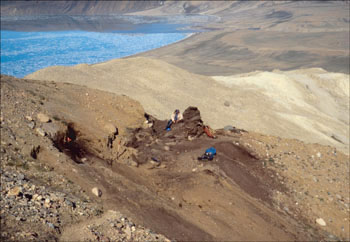Browse "Geology"
-
Article
Alberta Hilda Dinosaur Mega-Bonebed
The site is important because it confirms that Centrosaurus was a herding dinosaur, and documents that the herds were larger than previously thought, numbering well into the thousands.
"https://d2ttikhf7xbzbs.cloudfront.net/media/media/02a642a0-0d77-4886-9c75-55a389c9b77a.jpg" // resources/views/front/categories/view.blade.php
https://d2ttikhf7xbzbs.cloudfront.net/media/media/02a642a0-0d77-4886-9c75-55a389c9b77a.jpg
-
Article
Bathurst Island Plant Fossils
Early land plants have long been known from Eastern Canada, thanks to pioneering work by Sir J. William Dawson, father of Devonian palaeobotany and principal of McGill University from 1855 to 1893. But this record poorly represented the earliest phase of land colonization.
"https://d2ttikhf7xbzbs.cloudfront.net/media/media/daa5f373-32af-4edc-9828-e379a3066c96.jpg" // resources/views/front/categories/view.blade.php
https://d2ttikhf7xbzbs.cloudfront.net/media/media/daa5f373-32af-4edc-9828-e379a3066c96.jpg
-
Article
Cave
Origins Lava tube caves, an important minor class, are formed by channelled outflow of molten lava in congealing flows. Sea caves most commonly result from erosion by waves.
"https://d2ttikhf7xbzbs.cloudfront.net/media/media/fe40d379-ae39-4fca-8978-e0102f93eb01.jpg" // resources/views/front/categories/view.blade.php
https://d2ttikhf7xbzbs.cloudfront.net/media/media/fe40d379-ae39-4fca-8978-e0102f93eb01.jpg
-
Article
CESAR
The main objective of the multidisciplinary expedition was to carry out a geological survey of the ridge. Researchers, therefore, brought a veritable geotechnical arsenal to bear on the polar ice to gather seismic, gravimetric, bathymetric and other data.
"https://development.thecanadianencyclopedia.ca/images/tce_placeholder.jpg?v=e9dca980c9bdb3aa11e832e7ea94f5d9" // resources/views/front/categories/view.blade.php
https://development.thecanadianencyclopedia.ca/images/tce_placeholder.jpg?v=e9dca980c9bdb3aa11e832e7ea94f5d9
-
Article
Coal in Canada
Coal is a fossil fuel that has been used as a source of energy in Canada since the 18th century. Canada is home to 0.6 per cent of the world’s coal resources. Most of the country’s coal reserves (over 95 per cent) are found in Alberta, British Columbia and Saskatchewan. In recent years, the environmental movement has opposed the coal industry for disrupting local ecosystems, creating adverse health effects and for its large contribution to the carbon-dioxide emissions that drive climate change. In an effort to curb harmful emissions, the federal government has signalled its intention to phase out traditional coal-fired electricity by 2030, and Alberta has a plan to achieve the same goal as a province.
"https://d2ttikhf7xbzbs.cloudfront.net/media/media/e219080a-2cd3-443e-baac-53a621e2b160.jpg" // resources/views/front/categories/view.blade.php
https://d2ttikhf7xbzbs.cloudfront.net/media/media/e219080a-2cd3-443e-baac-53a621e2b160.jpg
-
Article
Cypress Hills Eocene to Miocene Fossils
The CYPRESS HILLS and Swift Current Plateaux of southwestern Saskatchewan preserve Eocene, Oligocene, and Miocene FOSSILS 42 million to 16 million years old, in the Cypress Hills Formation. Faunas of at least 14 different ages are represented there.
"https://development.thecanadianencyclopedia.ca/images/tce_placeholder.jpg?v=e9dca980c9bdb3aa11e832e7ea94f5d9" // resources/views/front/categories/view.blade.php
https://development.thecanadianencyclopedia.ca/images/tce_placeholder.jpg?v=e9dca980c9bdb3aa11e832e7ea94f5d9
-
Article
Devon Island Miocene Fossils
FOSSIL bones were first discovered in 1978 in the rocks formed in the now vanished Haughton Lake.
"https://development.thecanadianencyclopedia.ca/images/tce_placeholder.jpg?v=e9dca980c9bdb3aa11e832e7ea94f5d9" // resources/views/front/categories/view.blade.php
https://development.thecanadianencyclopedia.ca/images/tce_placeholder.jpg?v=e9dca980c9bdb3aa11e832e7ea94f5d9
-
Article
Drumlin
Drumlin, smooth, half egg-shaped or ellipsoidal hill which formed beneath Quaternary GLACIERS. Drumlins [Gaelic druim, "hill"] were first described in Ireland. They lie parallel to the direction of ice movement, the blunt (stoss) end facing up-glacier, the lee sloping down-glacier.
"https://development.thecanadianencyclopedia.ca/images/tce_placeholder.jpg?v=e9dca980c9bdb3aa11e832e7ea94f5d9" // resources/views/front/categories/view.blade.php
https://development.thecanadianencyclopedia.ca/images/tce_placeholder.jpg?v=e9dca980c9bdb3aa11e832e7ea94f5d9
-
Article
Earthquake
An earthquake is a vibratory motion generated from the movement of rock along a fault line beneath the Earth’s surface.
"https://development.thecanadianencyclopedia.ca/images/tce_placeholder.jpg?v=e9dca980c9bdb3aa11e832e7ea94f5d9" // resources/views/front/categories/view.blade.php
https://development.thecanadianencyclopedia.ca/images/tce_placeholder.jpg?v=e9dca980c9bdb3aa11e832e7ea94f5d9
-
Article
Ellesmere Island Eocene Fossils
Having been mapped on foot, by dogsled, and from the air by rugged geologists from the GEOLOGICAL SURVEY OF CANADA, the Canadian High Arctic was untouched by vertebrate palaeontologists until the mid-1970s.
"https://d2ttikhf7xbzbs.cloudfront.net/media/media/aad2c212-c087-43c4-8332-2d38b2f04f6d.jpg" // resources/views/front/categories/view.blade.php
https://d2ttikhf7xbzbs.cloudfront.net/media/media/aad2c212-c087-43c4-8332-2d38b2f04f6d.jpg
-
Article
Ellesmere Island Pliocene Fossils
Toward the close of the Tertiary (5 to 2 million years ago) and the beginning of the ice age (Quaternary - about 2 million years ago), a beaver pond existed on what is now Canada's Ellesmere Island, Nunavut.
"https://d2ttikhf7xbzbs.cloudfront.net/media/media/4bdc5be8-286b-4108-81c1-9602995884ad.jpg" // resources/views/front/categories/view.blade.php
https://d2ttikhf7xbzbs.cloudfront.net/media/media/4bdc5be8-286b-4108-81c1-9602995884ad.jpg
-
Article
Erosion
Erosion caused in this case by an intense thunderstorm squall lifting the soil from the fields (photo by Arjen Verkaik, Skyart Productions).This view depicts the eroding badlands and alternating beds of sandstone and shale (photo by Cliff Wallis, courtesy Cottonwood Consultants Ltd.).One of the classic, and disastrous, examples of gravitational erosion (photo by Ken A. Meisner/Take Stock Inc).The prairie dry belt was unwisely opened for homesteading and was struck by successive droughts in the 1920s...
"https://d2ttikhf7xbzbs.cloudfront.net/media/media/698e80ed-51d4-40c7-a75f-36d14b5e66b3.jpg" // resources/views/front/categories/view.blade.php
https://d2ttikhf7xbzbs.cloudfront.net/media/media/698e80ed-51d4-40c7-a75f-36d14b5e66b3.jpg
-
Article
Esker
An esker is a ridge (Gaelic eiscir, "ridge") of gravel and sand emplaced during glacial melt by the deposition of sediments from meltwater rivers flowing on the ice (channel fills) or beneath a glacier (tunnel fills).
"https://development.thecanadianencyclopedia.ca/images/tce_placeholder.jpg?v=e9dca980c9bdb3aa11e832e7ea94f5d9" // resources/views/front/categories/view.blade.php
https://development.thecanadianencyclopedia.ca/images/tce_placeholder.jpg?v=e9dca980c9bdb3aa11e832e7ea94f5d9
-
Article
Fossil
Fossil [Lat fossilis, "dug up"], trace of an ancient animal or plant preserved in the Earth's crust. Palaeontology is the modern, scientific study of fossils, but these curious objects have attracted attention since ancient times.
"https://development.thecanadianencyclopedia.ca/images/tce_placeholder.jpg?v=e9dca980c9bdb3aa11e832e7ea94f5d9" // resources/views/front/categories/view.blade.php
https://development.thecanadianencyclopedia.ca/images/tce_placeholder.jpg?v=e9dca980c9bdb3aa11e832e7ea94f5d9
-
Article
Fossil and Dinosaur Bonebeds
Part of a macrofossil, ceratopsian (horned) dinosaur bonebed at Dinosaur Provincial Park, Alberta (courtesy David A. Eberth).Fossil and Dinosaur Bonebeds Bonebeds are notable accumulations of modern or FOSSIL bones and teeth from more than one individual that occur in a geologic stratum or on the surface of the ground. Although modern bonebeds are common, the term is most often used in reference to ancient occurrences, in particular, fossil bones of large animals such as DINOSAURS...
"https://d2ttikhf7xbzbs.cloudfront.net/media/media/02a642a0-0d77-4886-9c75-55a389c9b77a.jpg" // resources/views/front/categories/view.blade.php
https://d2ttikhf7xbzbs.cloudfront.net/media/media/02a642a0-0d77-4886-9c75-55a389c9b77a.jpg
